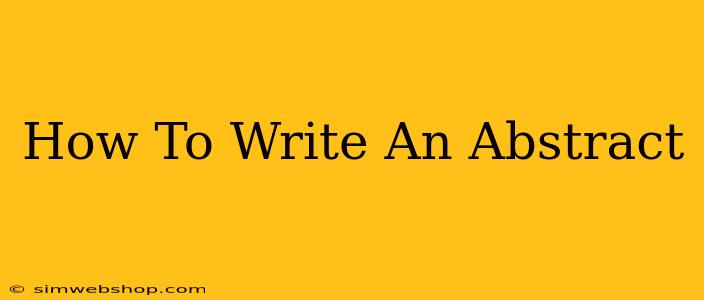Writing a compelling abstract is crucial for getting your research noticed. A well-crafted abstract is a concise summary of your work, acting as a gateway for potential readers to delve into the full text. This guide will walk you through the process, equipping you with the skills to write abstracts that grab attention and effectively communicate the essence of your research.
Understanding the Purpose of an Abstract
Before diving into the writing process, it's vital to understand the abstract's purpose. It serves as a standalone piece, providing readers with enough information to:
- Grasp the core topic and research question: Clearly state what your research is about.
- Understand your methodology: Briefly explain your approach and methods.
- Comprehend your key findings: Summarize the main results and conclusions.
- Assess the relevance and significance: Highlight the importance and implications of your work.
Essentially, your abstract acts as a persuasive advertisement for your full research paper.
Key Components of a Strong Abstract
A well-structured abstract typically includes these elements:
1. Background/Introduction:
- Set the context: Briefly introduce the topic and its significance. What problem are you addressing? What gap in knowledge does your research fill? This section should immediately grab the reader's attention.
2. Methods:
- Summarize your approach: Concisely describe your research methods. This could include the type of study (e.g., experimental, observational, qualitative), participants or data sources, and key analytical techniques. Use keywords related to your methodology.
3. Results:
- Present key findings: Report the most important results of your study. Focus on the main findings that support your conclusions, using quantifiable data where appropriate.
4. Conclusion/Implications:
- State the significance: Summarize your conclusions and discuss their implications. What are the broader implications of your findings? What are the next steps in this area of research? This section should leave a lasting impression on the reader.
Tips for Writing an Effective Abstract
- Keep it concise: Adhere to word limits strictly. Most journals specify a word count, so carefully follow the guidelines. Brevity is key.
- Use strong verbs: Active voice enhances clarity and conciseness.
- Avoid jargon and acronyms: Unless they are standard and widely understood within your field.
- Proofread meticulously: Errors undermine credibility. Thoroughly review your abstract for grammar, spelling, and punctuation errors.
- Tailor it to your audience: Consider who will be reading your abstract and adjust your language accordingly.
- Read examples: Analyze abstracts from published papers in your field to understand best practices.
- Seek feedback: Ask colleagues or mentors to review your abstract for clarity and effectiveness.
Keywords are Your Friends
Choosing the right keywords is crucial for improving your abstract's visibility in online searches. Identify the most relevant keywords related to your research topic, methods, and findings. Naturally incorporate these keywords throughout your abstract without compromising readability.
Abstract Examples: A Quick Look
While the specifics will vary greatly depending on the field of study and the type of research, you can find many examples of abstracts within your discipline's leading journals. Look at the structure and flow of successful abstracts to learn from the experts.
By following these guidelines, you can craft a compelling abstract that effectively communicates the essence of your research and increases its visibility and impact. Remember, your abstract is often the first – and sometimes only – impression you make on a potential reader. Make it count!

